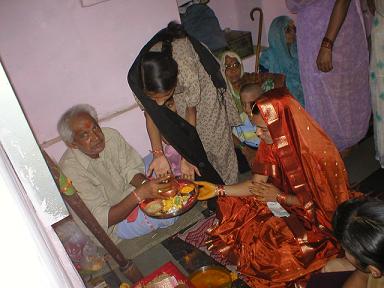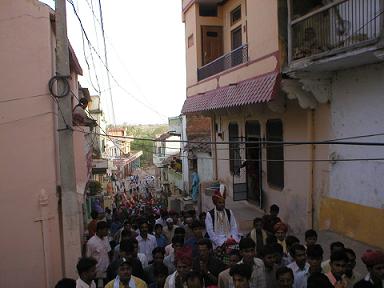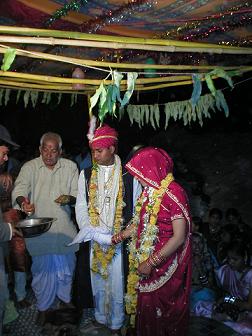|
PRE-BIRTH RITUALS
Paani Peene Jaana (Godh Bharana)
In the seventh month of pregnancy, the expectant mother is taken to
her father's place (peehar). This is called paani peene jana, literally
meaning to partake water from her father's household. In most cases
the expectant mother is at her father's home when the first child is
born.
BIRTH RITUALS
Birth
Things required:
Flat bronze thali and a stick, in case of the boy child
Chaaj or winnowing fan, in case of the girl child
Once a child is born, depending upon whether the child is a boy or a
girl, a thali (a flat bronze utensil) is beaten with a stick
in case a boy is born and a chhaj, the fan used for winnowing
is beaten in case a girl is born.
Guthki Ceremony
Things required:
Jaggery dipped in pure ghee
After the umbilical cord is cut, the new born is bathed and given to
suck the guthki (the first food after birth ) which is jaggery
dipped in pure ghee .This is considered auspicious as well as
helpful to the child in learning to suck. Normally elderly relatives
i.e. grandmother or an elder aunt gives the guthki in order that
the child may imbibe the finer qualities of the person.
Badhai
The news of the birth of a child is conveyed to the grandfather, father
and other relatives of the child by a messenger sent from the maternal
side. The messenger, who may be a Brahmin or a barber from the village,
is rewarded with gifts in cash and kind including new clothes by the
child's paternal side.
Sooraj
Poojan and Naamkaran
Things required:
Milk , thaal for pooja containing kumkum, rice
kalash or pot , bunch of neem leaves
ajwain cooked in jaggery and pure ghee.
Six days after the birth of the child, on the seventh day the young
mother is bathed and clothed in new attire while women of the community
sing songs in praise of the Sun God and the suhagan (married
woman whose husband is alive). On this day, the young mother takes the
child in her lap and sits facing the Sun. Milk is offered to the Sun
God by the young mother from her breast and the sister-in-law (nanad)
performs the aarti of the new-born baby and the mother. The "puja
ki thali" contains kumkum, rice, a kalash in which a bunch
of neem leaves are dipped and ajwain cooked in gur and pure ghee.
The auspicious time (mahurat) for the Sooraj poojan
and naamkaran ceremony is sought from the family priest who according
to planetary positions, nakshatra and lagna decides a
suitable date as well as the name of the child, which he announces on
the day of the sooraj poojan ceremony.
Balunda
When the child is a couple of months old, relatives from the new father's
side are invited and feasted. On this occasion the maternal grandparents
gift the newborn with silver/gold ornaments. After staying for a couple
of days at the young mother's parents house, the father and his close
relatives go back to their own village with the new- born and his mother.
Dhoondh
Things required:
New clothes , Bajotia ( an ornamental wooden seat ) , Lathis
(batons)
Dhoondh ceremony is performed for all children born in the Hindu
calendar year before Holi ( festival of colours ). In this, the child
is dressed in new clothes and seated in the lap of a near relative on
a Bajotia ( an ornamental wooden seat ) while the Gherias (singers
and dancers reveling in the spirit of Holi ) dance around them beating
their long handled staffs (lathis ) and bless the child. The Gherias
are rewarded and feasted by the family.
MARRIAGE RITUALS
Vinayak Sthapana

Once the marriage has been fixed, the first and foremost ritual performed
is to install the idol of Lord Vinayak ( Ganesha - the God of auspicious
beginning of new ventures ) in the household. The women of either side
go to the village potter's house and reverentially bring home the clay
idol of Lord Ganesha to the accompaniment of a Dhadi, beating a drum
(Dhol).
Ghrit-Paan Ceremony
With the happy news of the settlement of the proposed marriage, preparations
are started at the girl's home .The home is cleaned and renovated, walls
are repaired and the kuchcha(uncemented) floor is layered which is called
angana neepna. On a pre-decided auspicious day (except Monday and Tuesday)
this ceremony is performed. The floor is decorated with beautiful designs,
locally known as mandna. A bajotia (a wooden seat) is kept on one of
the mandnas and the bride-to-be is made to sit on it. All women from
the neighbourhood are invited and they rejoice singing wedding songs.
Ghee and Gur ( jaggery ) are taken in a bowl and the priest makes the
girl eat it. All the women are given jaggery as prasad. From this day
on a paste of turmeric, wheat flour and ghee which is considered a cleansing
agent is applied daily to the bride -to -be, by a female belonging to
the village barber family, till the day of marriage.
Bandola
After the ghrit -paan ceremony all the meals the bride takes are not
in her own home but in the homes of other people of the community. She
goes with her closest friends and familyand relatives to eat the bandola
. The food served is halwa, lapsee( a concoction made of dalia , gur
and ghee ), kheer and other homemade sweets. In the evenings after the
bandola, all women and children dance and sing to the beat of the dhol
while all the members of the village community participate with great
interest and reverence.
Bandoli
The special dinner for the day before the date scheduled for the marriage
is called bandoli, and is sponsored by the closest relatives of the
girl's family . After the meals, the girl is dressed in new attire and
taken to the village mandir ( temple ) in a procession to the accompaniment
of music and dance. Coconut and cash offerings are made and blessings
of the lord are sought for a happy and prosperous married life.
At the Groom's

The ghrit paan ceremony and the bandolas are the same, as the bride's
at the boys place. However, for the bandoli, the clothes for the groom-
to- be are from his maternal uncle's home . His maternal uncle and brother-in-law
are supposed to be present for the bandoli. Thereafter, the boy is seated
on a ghori ( mare ) and is made to take a round of the village accompanied
by the beat of the dhol.
Ratijoga
On the eve of
the marriage ceremony, an earthen pot filled with ghee is lighted and
kept in front of an idol of God while women sing songs throughout the
night . In the morning everybody is given prasad (gur and coconut ).
Day of Marriage
On the day of
marriage, everybody is busy preparing for the reception of the baraat
and cooking the feast. The ceremony itself is scheduled for the night.
Unlike the practice in cities, where marriage parties hire caterers,
the food for the marriage in villages is prepared by the men of the
community in utensils owned by the community called kadavs. All the
work relating to cooking and serving the meals is undertaken by relatives
and friends. The men engaged in preparing the food are busy discussing
about the marriage while the women at home engage in rejoicing and singing,
eulogizing the groom and the bride, besides singing other songs devoted
to various deities including Mata Jagdambe and all Gods and Goddesses.
At the groom's place the baraat (marriage procession), is supposed to
leave in the evening and the day is spent in feasting and other forms
of rejoicing including singing and dancing. Then the boy is groomed
and dressed in the ceremonial marriage clothes and a sword is always
carried by the Beend (the groom) till he returns back with his bride.
This signifies that in earlier days brides had to be won in wars. The
baraat is received by the village barber and guided to the place where
arrangements have been made for the party to stay.
Padla
The groom's close relatives proceed to the bride's home with the ornaments
and marriage clothes meant for the bride, which are displayed for the
family elders to see and approve. This is called the padla ceremony.
Toran Vandana
Prior to the appointed hour for the marriage ceremony the bridegroom
arrives at the threshold of the bride in a procession where a toran
( wooden symbolic carving of Lord Ganesha placed on the entrance of
the house ), is placed to welcome him. The bridegroom salutes the toran
by touching it with his sword and a green twig of a Ber ( desert tree
). The mother- in- law applies tilak on the forehead of the groom and
ushers him in.
Phera

The marriage ceremony is performed around a havan vedi prepared by the
priest. Shlokas and mantras are chanted by the priest while the parents
of the bride pour havan samagri in the fire as directed by the priest.
The womenfolk of both sides sing marriage songs praising their own child
and teasing the other party. The most important ritual in the wedding
ceremony is the Pheras (going around the sacred fire) and taking vows
to support each other to make the marriage a happy and successful venture.
Normally four pheras are taken but in certain cases seven pheras may
also be taken. The bride leads the way in the first couple of pheras,
and the groom in the remaining ones.
Kanya Daan
Towards the close of the marriage ceremony, the father of the bride
performs kanya daan, meaning giving away his daughter to the bridegroom.
Amidst chanting of shlokas and mantras and the singing by the ladies,
the priest calls for the close relatives to offer their gifts to the
bride. Normally milch cattle, ornaments and cash gifts are given.
Baar ( Dwar ) Rokna
The sisters of the groom welcome the brother and his bride at the entrance
to their house and traditionally block the way, which is known as Baar
Rokna ritual. The bridegroom 'appeases' the sisters with gifts in cash,
jewellery or milch cattle. The rural traditions of ancient India thus
prove that the sisters were always adequately compensated in lieu of
their share in the parental property
Mayera
Most families are land owners in the rural areas of Rajasthan. While
the boys inherit the land, the girls are compensated during the mayera
ceremony with gifts in cash, silver and gold ornaments. Mayera or the
gift giving ceremony is normally arranged at the time of a marriage
in the girl's family. Although it was started with the noble motive
of equitable distribution of wealth among brothers and sisters, the
practice has degenerated into a status symbol of late.
DEATH RITUALS
Cremation
Things required:
A lamp , Wheat flour , Incense sticks , A bag made of cotton cloth white
for a male and red for a female
As per Hindu traditions, once a person dies, his body is laid on the
ground. While relatives gather around the body to grieve and pay their
respects to the departed soul, the priest is called who performs the
rites relating to the last journey, while the other elders of the village
community gather to offer condolences and solace to the bereaved family
and offer help in arranging for the cremation . The priest lights a
lamp made of wheat flour and incense sticks and chants mantras while
preparing the body for the last rites The dead body is given a bath
and dressed in new clothes and subsequently, a procession is taken to
the cremation ground. While the body of the deceased is taken out of
his home, it is brought out head first. The procession chants Ram
naam satya hai, satya se mugat hai (only the name of God is the
truth and the truth paves the way for salvation). The bodies are cremated
and the body is consigned to flames. Kapal kriya or shattering the skull
of the deceased, is performed by the elder son .
Ganga Snan
The ashes and bones of the deceased are collected and kept in a bag
made of cotton cloth white for a male and red for a female. The ashes
are then taken to the holy city of Hardwar to be immersed in the holy
Ganges. All these rituals are performed under the supervision of priests
at the place of birth of the deceased, as also at Hardwar. Holy water
of the river Ganges (Ganga jal) is brought for puja on the 12th day
after which the departed soul is believed to be liberated from all attachments.
|